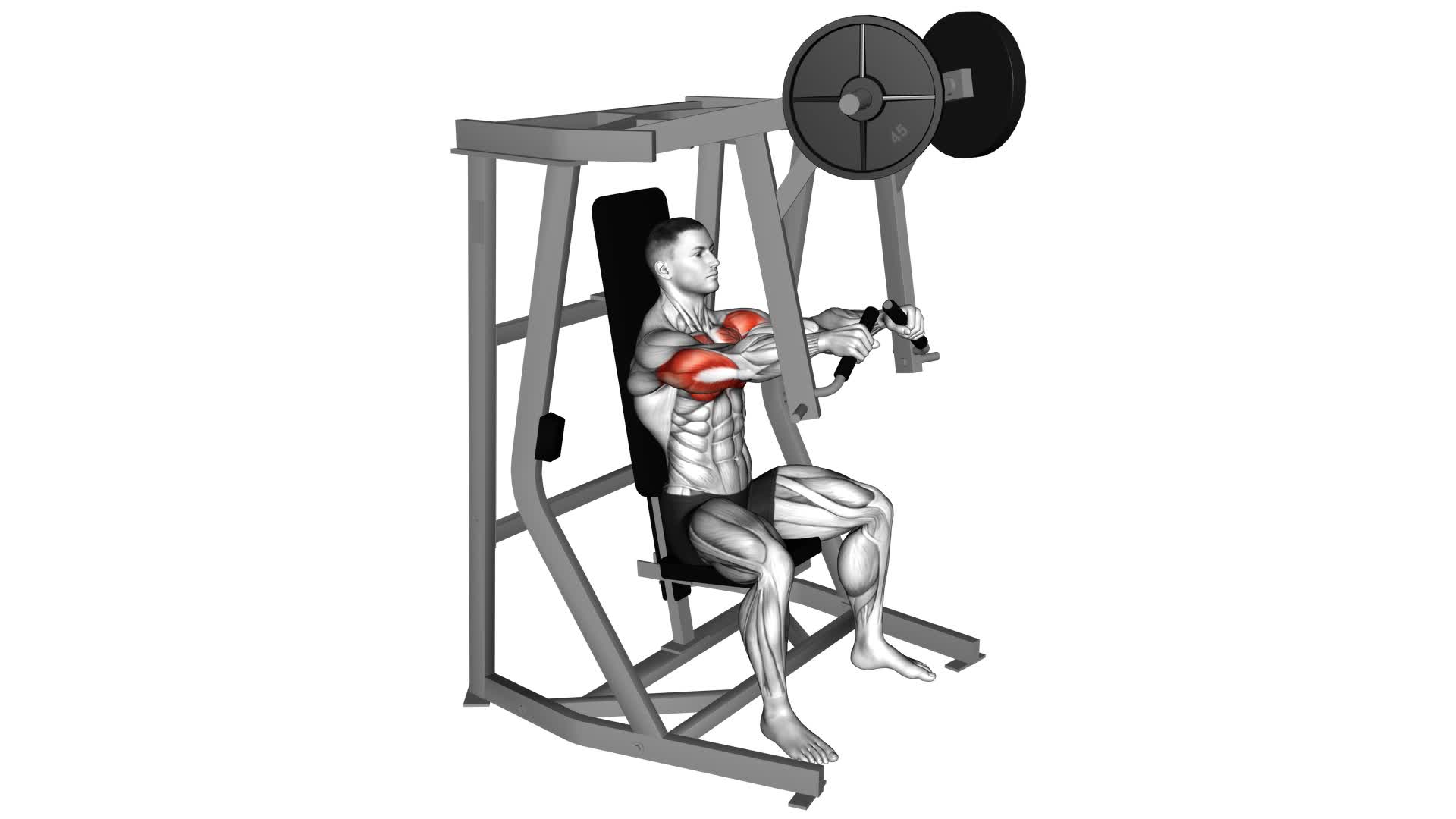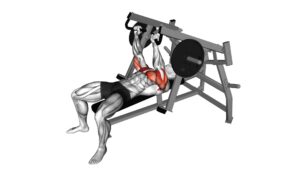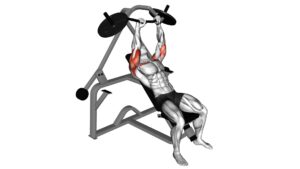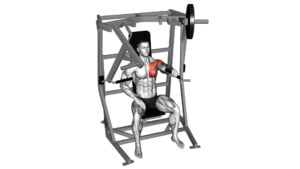Lever Chest Press (Plate Loaded) – Video Exercise Guide & Tips

Are you looking to strengthen your chest muscles? The lever chest press, a plate loaded exercise, could be just what you need.
Watch This Exercise Video
In this video exercise guide, we'll show you the proper form and technique to maximize your results. Avoid common mistakes and try out different variations to keep challenging yourself.
With our tips and guidance, you'll be on your way to achieving a stronger chest in no time. Let's get started!
Key Takeaways
- Lever chest press targets the pectoralis major and minor muscles, increasing muscle strength and improving upper body stability.
- Proper form and technique, such as maintaining a stable upper body, keeping the back flat against the bench, and using a slightly wider than shoulder-width grip, are crucial for maximizing the benefits of lever chest press.
- Common mistakes to avoid include arching the back excessively, using too much weight, breathing incorrectly, and performing repetitions too quickly.
- Variations and progressions of lever chest press, such as trying different types of chest presses, adjusting the bench angle, incorporating unilateral movements, and using different equipment options, can help challenge stability, address muscle imbalances, and enhance muscle engagement.
Benefits of Lever Chest Press
Get stronger and build muscle in your chest by incorporating the lever chest press into your workout routine.
The lever chest press is a highly effective exercise that targets the muscles in your chest, specifically the pectoralis major and minor. This exercise involves pushing a lever with weighted plates away from your body using your chest muscles.
One of the key benefits of the lever chest press is increased muscle strength. By regularly performing this exercise, you can gradually increase the weight and resistance, which will challenge your muscles and lead to strength gains. This is important not only for aesthetic purposes but also for functional strength in everyday activities.
Another benefit of the lever chest press is improved upper body stability. This exercise requires you to stabilize your upper body while pushing the lever, which helps to strengthen the muscles in your shoulders, back, and core. This increased stability can have a positive impact on your overall posture and can also help to prevent injuries during other exercises or physical activities.
Incorporating the lever chest press into your workout routine can provide you with numerous benefits, including increased muscle strength and improved upper body stability. Remember to start with lighter weights and gradually increase the resistance as your strength improves. Always maintain proper form and technique to maximize the effectiveness of this exercise.
Proper Form and Technique
To perform the lever chest press with proper form and technique, focus on maintaining a stable upper body while pushing the lever away from your chest. This exercise primarily targets your chest muscles, but also engages your shoulders and triceps.
It's important to dispel some common misconceptions about this exercise. Firstly, many people believe that arching the back or lifting the hips off the bench will help them push more weight. However, this can actually put unnecessary strain on the lower back and compromise form. Instead, keep your back flat against the bench and your feet firmly planted on the ground.
Secondly, some individuals may think that using a wider grip will target the chest more effectively. However, a wider grip can place excessive stress on the shoulder joints. It's recommended to use a grip that's slightly wider than shoulder-width apart to maintain proper alignment.
In terms of equipment setup, make sure the lever is positioned at chest level and adjust the seat height so that your feet are flat on the ground.
Now that you understand the proper form and equipment setup, let's move on to discussing common mistakes to avoid.
Common Mistakes to Avoid
Avoiding common mistakes is crucial when performing the lever chest press exercise. To ensure you get the most out of your workout and minimize the risk of injury, keep the following points in mind:
- Maintaining proper form: Keep your back firmly pressed against the bench throughout the movement and avoid arching it excessively. This helps to engage the target muscles effectively and prevents strain on your lower back.
- Using appropriate weight: Start with a weight that challenges you but allows you to maintain proper form. Using too much weight can compromise your technique and increase the risk of injury.
- Breathing correctly: Remember to exhale as you push the weight away from your body and inhale as you bring it back down. Proper breathing helps to stabilize your core and maintain control throughout the exercise.
- Avoiding excessive speed: While it may be tempting to rush through the repetitions, maintaining a controlled and steady pace is essential. This ensures that you're targeting the intended muscles and reduces the risk of strain or injury.
- Importance of warm-up: Prior to starting the lever chest press, it's crucial to warm up your muscles with some light cardio or dynamic stretching. This helps increase blood flow and prepares your muscles for the upcoming workout.
Variations and Progressions
To progress and challenge yourself further, there are several variations of the lever chest press exercise that you can incorporate into your workout routine. These advanced modifications will help you target different muscles and enhance your overall strength and muscular development.
One option for variation is to use different equipment. Instead of using a plate-loaded machine, you can try a barbell chest press or dumbbell chest press. These exercises require more stabilization and engage more muscles, providing a greater challenge for your chest and upper body.
Another option is to adjust the angle of the bench. By inclining or declining the bench, you can target different areas of your chest and increase the difficulty of the exercise. Incline chest presses primarily target the upper chest, while decline chest presses focus more on the lower chest.
You can also incorporate unilateral movements by using one arm at a time. This will help improve your balance and stability, as well as address any muscle imbalances that may exist.
By incorporating these advanced modifications and equipment options into your lever chest press routine, you can continue to challenge your muscles and progress towards your fitness goals.
Now, let's move on to the next section for some tips on how to achieve maximal results.
Tips for Maximal Results
Get the most out of your lever chest press workout by focusing on proper form and technique. Here are five tips to help you maximize gains and optimize performance:
- Engage your core: Keep your abdominals tight throughout the exercise to stabilize your body and prevent excessive arching of the lower back.
- Use a full range of motion: Lower the weight until your elbows are at a 90-degree angle and then push the weight back up to fully extend your arms. This ensures that you're effectively targeting your chest muscles.
- Maintain proper breathing: Inhale as you lower the weight and exhale as you push it back up. This helps you maintain control and stability throughout the movement.
- Adjust the seat position: Make sure the seat is at a height that allows your elbows to be slightly below shoulder level when your hands are on the handles. This ensures proper alignment and prevents unnecessary strain on the shoulders.
- Gradually increase the weight: As you become stronger, gradually increase the amount of weight you're lifting. This progressive overload stimulates muscle growth and helps you continue making progress.
Frequently Asked Questions
What Is the Weight Range Typically Used for Lever Chest Press Exercises?
When doing the lever chest press exercise, you might be wondering about the weight range typically used. The weight range can vary depending on your fitness level and goals.
It's important to start with a weight that challenges you but still allows you to maintain proper form. As you progress, you can gradually increase the weight to continue improving your posture and strength.
Can Lever Chest Press Exercises Help With Improving Posture?
Lever chest press exercises can be beneficial for improving your posture. By targeting the muscles in your chest, shoulders, and upper back, these exercises can help correct rounded shoulders and promote better alignment.
Additionally, lever chest press exercises are effective for building upper body strength. Incorporating them into your workout routine can help you develop a stronger and more balanced upper body, leading to improved posture and overall muscle stability.
Are There Any Specific Warm-Up Exercises Recommended Before Performing the Lever Chest Press?
Before performing the lever chest press, it's important to do specific warm-up exercises. These exercises help prepare your muscles for the workout and reduce the risk of injury. They can include shoulder stretches, arm circles, and light chest presses with lighter weights.
The lever chest press itself has various benefits, such as strengthening the chest, shoulders, and triceps. It also helps improve upper body stability and can contribute to overall posture improvement.
How Often Should Lever Chest Press Exercises Be Included in a Workout Routine?
Including lever chest press exercises in your workout routine can provide numerous benefits for your chest muscles. It's recommended to perform this exercise at least 2-3 times a week to see optimal results.
Remember, there are also various variations of chest press exercises that you can incorporate to add variety and challenge to your routine.
Make sure to consult with a fitness professional to ensure proper form and technique.
Can Lever Chest Press Exercises Be Modified for Individuals With Shoulder or Wrist Injuries?
If you have shoulder or wrist injuries, you may need to modify your lever chest press exercises. There are alternative exercises that can still target your chest muscles without putting strain on your injured areas.
Consult with a fitness professional or physical therapist to find out the best modifications for your specific condition. They can recommend exercises that will allow you to work your chest effectively while minimizing the risk of further injury.
Conclusion
In conclusion, the lever chest press is an effective exercise for targeting the chest muscles.
By maintaining proper form and technique, avoiding common mistakes, and incorporating variations and progressions, you can maximize your results.
Remember to consult with a fitness professional if you have any concerns or questions about performing this exercise correctly.
Stay consistent and dedicated to your training to achieve the best possible outcomes.

Author
Years ago, the spark of my life’s passion ignited in my mind the moment I stepped into the local gym for the first time. The inaugural bead of perspiration, the initial endeavor, the very first surge of endorphins, and a sense of pride that washed over me post-workout marked the beginning of my deep-seated interest in strength sports, fitness, and sports nutrition. This very curiosity blossomed rapidly into a profound fascination, propelling me to earn a Master’s degree in Physical Education from the Academy of Physical Education in Krakow, followed by a Sports Manager diploma from the Jagiellonian University. My journey of growth led me to gain more specialized qualifications, such as being a certified personal trainer with a focus on sports dietetics, a lifeguard, and an instructor for wellness and corrective gymnastics. Theoretical knowledge paired seamlessly with practical experience, reinforcing my belief that the transformation of individuals under my guidance was also a reflection of my personal growth. This belief holds true even today. Each day, I strive to push the boundaries and explore new realms. These realms gently elevate me to greater heights. The unique combination of passion for my field and the continuous quest for growth fuels my drive to break new ground.



